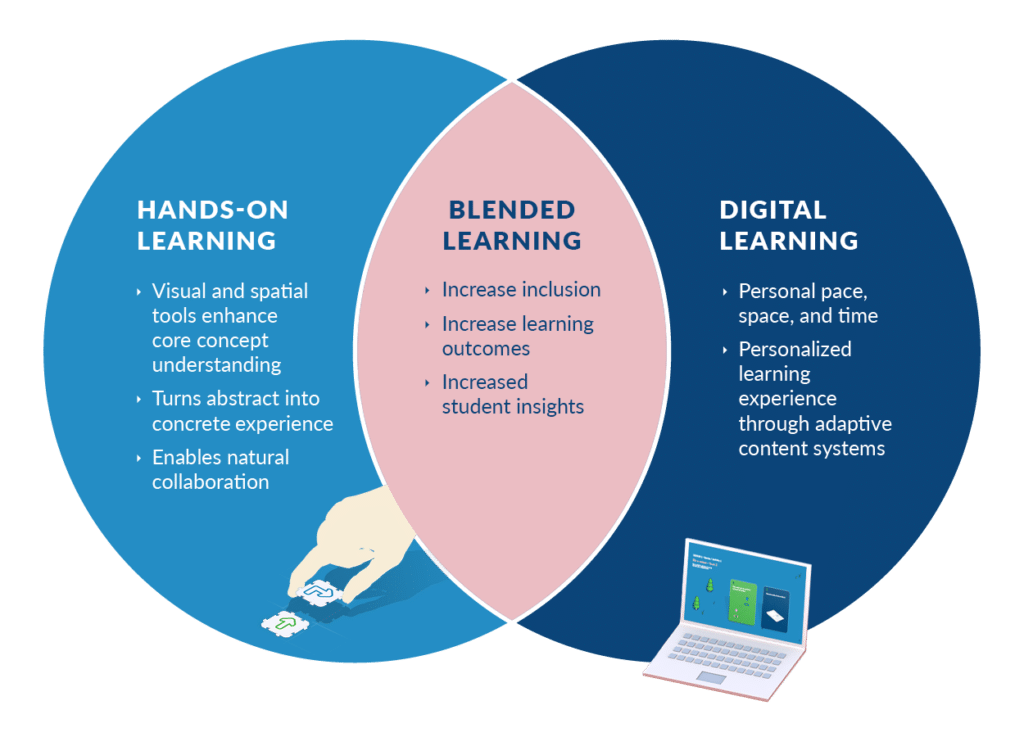In the ever-evolving landscape of healthcare, staying ahead requires a combination of knowledge, adaptability, and innovation.
While the traditional classroom has long been the cornerstone of learning, the emergence of blended learning has opened up a world of possibilities that transcends the conventional boundaries of education.
Blending the best of both worlds — face-to-face instruction and digital resources — this modern approach has taken center stage, revolutionizing healthcare training in remarkable ways.
In this article, we’ll explore creative applications of blended learning that are reshaping how healthcare professionals learn, grow, and thrive in their dynamic roles.
Let’s delve into a realm where technology and traditional teaching converge, unlocking unprecedented opportunities for healthcare education.
Understanding the evolution of healthcare training: blended learning approach

The landscape of medical education has witnessed a remarkable evolution over the years. Gone are the days when learning was confined to lecture halls and textbooks alone.
The introduction of blended learning in healthcare has allowed for the convergence of technology and classic teaching approaches, completely transforming how healthcare professionals access information, sharpen their abilities, and face the challenges of their ever-evolving roles.
Blended learning represents a break from the classical classroom-based method, embracing a more comprehensive and adaptive approach to education. Combining physical instruction with digital tools creates medical training that is engaging, dynamic, and personalized.
Here are the key components of this model:
- Conventional classroom instruction
- Incorporation of digital materials
- Interactive eLearning
- VR and AR
- Collaborative online communities
Let’s explore some innovations in more detail.
Virtual simulation for real-world scenarios

In the realm of medical training, the transition from theory to practice has long been a critical challenge. Aspiring specialists grapple with the difficult task of applying their knowledge and skills in real-world scenarios, where decisions can have profound consequences.
Enter virtual simulation, an extraordinary advancement in blended learning apps that bridges the gap between theory and practice like never before.
The new teaching and learning methods pushed the boundaries further with the integration of virtual simulations and augmented reality. These technologies provide healthcare professionals with realistic scenarios to practice complex procedures, surgical techniques, and critical decision-making in a risk-free environment.
Learners gain invaluable hands-on experience, building confidence and competence before entering real-world clinical settings.
Imagine being able to practice intricate surgical procedures, make critical diagnostic decisions, or manage complex patient scenarios, all in a safe and controlled virtual environment.
Simulation offers precisely that, providing learners with the opportunity to gain hands-on experience, refine their clinical judgment, and build confidence without risking patient safety.
Whether it’s performing a delicate surgery, responding to an emergency situation, or managing a challenging patient case, this remarkable invention allows learners to navigate these scenarios with precision and without the fear of real-life consequences.
One of the greatest advantages of virtual simulation is its ability to recreate a wide range of scenarios that professionals may encounter in their practice.
From routine procedures to high-stakes emergencies, they can be tailored to mimic real-life situations, complete with realistic patient responses, environmental factors, and time constraints.
Thanks to pioneering healthcare training apps, learners are immersed in these scenarios, challenged to make critical decisions, and guided through instant feedback and debriefing sessions.
Mobile learning for on-the-go education

As technology advanced, interactive platforms emerged, offering engaging and immersive learning experiences. They introduced multimedia elements, exciting quizzes, simulations, and virtual patient scenarios.
Learners could now actively participate in the educational process, reinforcing their understanding and honing their clinical decision-making skills.
Medical students and specialists don’t have to sit in classrooms for hours on end to receive the training they need. With healthcare training apps, education is available at the touch of a button, anytime, anywhere.
The world is moving at an unprecedented pace, and medical workers need to keep up. With mobile learning, they can do just that. One can easily learn about the latest treatment options, emerging trends, and best practices while on the go, all from the palm of their hand.
Also, inclusivity in medical education has taken a front seat. Innovative developers have recognized the importance of accessibility and have designed apps for deaf users, ensuring that the interactive learning experience is not confined to those who can hear.
These apps employ visual learning cues, sign language interpretation, and closed captioning, allowing deaf individuals to partake fully in medical education and patient care simulations.
Andersen experts say that mobile learning is more than just accessing training materials on a smartphone or tablet. It’s a holistic approach that leverages the power of technology to deliver a seamless and engaging learning experience.
It provides learners with access to a wide range of educational resources, from e-books to videos, podcasts, and interactive quizzes. The content is tailored to the learners’ needs. This flexibility is especially crucial for those juggling demanding schedules and competing priorities.
Collaborative online learning communities

In the world of healthcare education, the adage “two heads are better than one” takes on new meaning with the rise of collaborative online learning communities.
In a vibrant digital space, specialists from diverse backgrounds and experiences come together to learn, share insights, and tackle complex challenges collectively. These communities harness the power of collective wisdom, fostering a spirit of collaboration and cooperation that elevates the learning journey to unprecedented heights.
Such communities are more than just discussion boards or forums. They are dynamic hubs of knowledge exchange, where learners become active participants in their education.
Digital platforms facilitate connections among professionals, transcending geographical boundaries and fostering a sense of camaraderie. By harnessing the collective knowledge, skills, and experiences of the community, specialists can tap into a vast pool of expertise that enriches their learning journey and widens their perspectives.
The strength of such communities lies in their ability to promote interactive and engaging discussions. Learners can take part in lively debates, share case studies, and seek advice from peers facing similar challenges.
The remarkable diversity nurtures an environment of constructive feedback and critical thinking, enhancing problem-solving skills and expanding clinical reasoning abilities. By engaging in active dialogue, learners not only solidify their own understanding but also contribute to the growth and development of their co-learners.
Personalized learning paths and adaptive assessments

For learning purposes, the one-size-fits-all approach is no longer sufficient. Each person brings a unique set of strengths, weaknesses, and aspirations.
Personalized learning paths and adaptive assessments are the dynamic duo that unlock the potential within every individual. Blended learning apps offer such opportunities.
Personalization embraces the notion that no two learners are alike. It takes into account learners’ prior knowledge, learning styles, and goals, allowing for a truly customized learning experience.
It provides learners with the flexibility and autonomy to progress at their own pace, ensuring that no one is left behind or held back by the constraints of a rigid curriculum.
According to Andersen’s healthcare experts, personalization alone is not enough. Adaptive assessments present an innovative tool that constantly assesses learners’ knowledge and adapts accordingly. No more generic, one-size-fits-all exams.
With this new approach, teaching professionals and smart AI algorithms analyze learners’ responses, identify areas of strength and weakness, and deliver tailored content and feedback based on individual needs.
Students are guided along a path that challenges them appropriately, ensuring optimal engagement and mastery of concepts. It’s a symbiotic relationship where learners inform the assessments and assessments inform the learners, fostering a continuous cycle of growth and improvement.
Conclusion
Blended learning is a formidable force, transcending the limitations of traditional classroom education. It has ushered in a new era of flexibility, accessibility, and collaboration.
Through virtual simulations, mobile learning, collaborative online communities, personalized learning paths, and adaptive assessments, specialists are equipped with the tools to navigate the ever-changing healthcare landscape with confidence and expertise.
If you need a robust platform for teaching and learning activities, turn to an experienced IT company. Skilled developers can build apps for blended learning of any complexity. Thus, you will be able to provide your staff with educational opportunities of unprecedented quality and span.
Related Posts:
- Gamification in Education: Game Design Principles to Engage Students
- A Decade of Transformative Travel & Hospitality IT Solutions
- How Artificial Intelligence is Changing the Way We Find Restaurants
- Effects Of Digitization Changing The Way We Conduct Business
- The Benefits of Strategic Technology Consulting for eCommerce
- How eCommerce Businesses Can Take Advantage Of Technology
